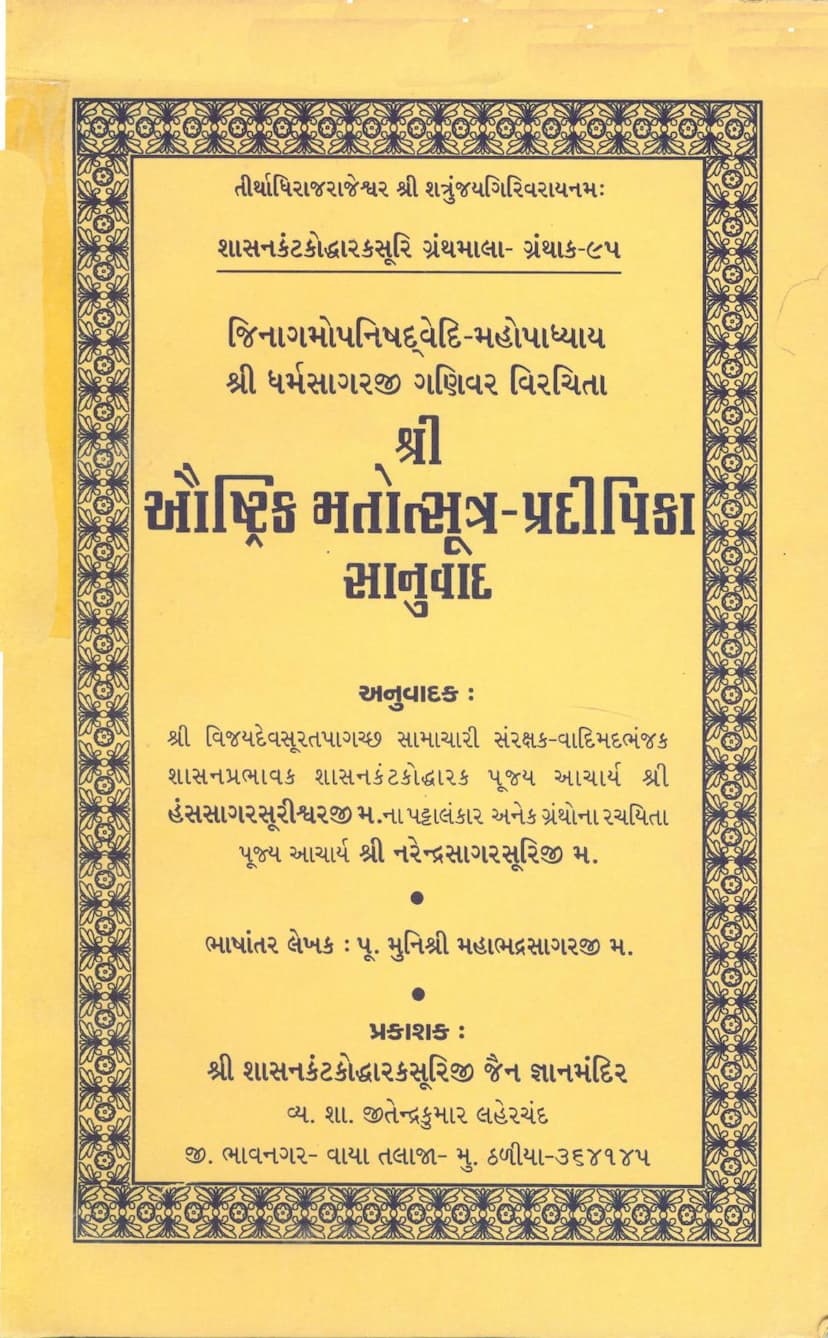Aushtrikmatotsutra Pradipika Sanuwad
Added to library: September 1, 2025

Summary
This is a summary of the Jain text "Austrikmatotsutra Pradipika Sanuwad" by Dharmsagar Gani, translated by Hanssagarsuri, and written by Mahabhadrasagar.
Context and Purpose:
The text is a commentary on a foundational Jain scripture, "Austrikmatotsutra," which addresses controversial doctrines attributed to the "Austrik" sect, later identified with the "Khartar" sect. The book aims to refute these unorthodox views, demonstrate their contradiction with authentic Jain teachings (Agamas), and re-establish the correct Jain principles and practices. The author, Dharmsagar Gani, lived in the 16th century and was a prominent scholar who actively defended the traditions of the Tapa Gachcha lineage of Jainism against various schismatic groups.
Key Arguments and Content:
The book is structured into four main sections (Adhikaras), systematically dismantling the Austrik/Khartar viewpoints:
1. Naming and Identity of Austrik:
- The text clarifies the origins and various names associated with this sect: Austrik, Chamundik, and Khartar.
- It traces the name "Austrik" to Jinadatta Acharya's flight on a camel (ushtra) from fear of the Sangh's reprimand.
- "Chamundik" is linked to Jinadatta Acharya's worship of the goddess Chamunda to promote his sect.
- "Khartar" is presented as an arbitrarily adopted name by Jinadatta, rather than a name derived from the teachings, unlike "Aanchalik" or "Tristutik." The author disputes the historical claims of the Khartar sect regarding the origin of their name and lineage, particularly their association with King Durlabh.
2. Refutation of Austrik Doctrines (Utsutra) with Agamic Evidence:
-
This section meticulously analyzes and refutes the "utsutra" (unorthodox) doctrines attributed to the Austrik sect. These are categorized into four types:
- Deficient Practices (Nyuna Kriya): This includes prohibitions on women's worship of Jinas, dancing girls in temples, fasting without specific observance days, cessation of monthly vows (Masakalpa), prohibitions on continuous fasting practices, restrictions on lay followers' speech, curtailment of vows for lay ascetics, and limitations on devavandana.
- Excessive Practices (Adhika Kriya): This includes practices like performing Samayika late at night, repeated chanting of the Samayika mantra, and rituals performed by monks that mirror lay practices.
- Improperly Placed Practices (Ayathasthan Kriya): This concerns the incorrect sequencing of rituals, such as performing Pratikramana after Samayika, or miscalculating festival dates like Paryushana based on lunar phases.
- False Assertions (Vastuvitath Prasanga): This category addresses outright false claims, such as attributing a sixth Kalyanaka (auspicious event) to Lord Mahavir, or the assertion that certain practices are not considered "mithyatva" (false belief) when they clearly are.
-
The author systematically contrasts these Austrik claims with the authentic teachings found in the Jain Agamas (scriptures) like Gnathadharmakathananga, Uttaradhyayana, Rajprashniya, Tatvartha Bhashya, Brihat Kalpa, Ogha Niryukti, and Mahanishitha Sutra.
3. Re-establishment of Right Faith (Samyaktva) for Those Who Have Lost It:
- This section addresses how to restore "Samyaktva" (right faith) in those who have been misled by the heretical doctrines and have consequently lost their true faith through the criticisms and insults directed at the Tirthankaras, Acharyas, and the Sangh.
- It explains that losing faith can be due to insult (ashatana) or the influence of passions (kashaya).
- The author emphasizes that true understanding of Jainism leads to the recognition of its superiority over other paths, and that genuine scholars are those who uphold the Agama.
4. Austrik's Own Account of the Refutation:
- This section, in a rhetorical style, presents Jinadatta Acharya's (and by extension, the Austrik sect's) justifications for their controversial practices, only to expose the flaws and contradictions within their own arguments.
- It dissects Jinadatta's purported reasons for restricting women's worship (citing imaginary instances of impurity and scripture misuse), his reasoning for refuting certain practices, and his misinterpretations of Jain tenets, all while highlighting his lack of understanding of both the Agamas and common social norms.
Author's Stance and Defense of Tapa Gachcha:
Dharmsagar Gani strongly defends the purity of the Tapa Gachcha's traditions, highlighting the scholarship and adherence to Agamic principles of his predecessors, particularly Acharya Vijaydan Suri and Acharya Hanssagarsuri. He criticizes those within the Tapa Gachcha who may have deviated from strict observance, but his primary focus is on combating external heresies. The text also emphasizes the historical lineage and correctness of the Tapa Gachcha's practices in contrast to the perceived deviations of the Khartar sect.
Overall Significance:
"Austrikmatotsutra Pradipika Sanuwad" is a vital text for understanding the theological debates within Jainism during the medieval period. It showcases Dharmsagar Gani's deep erudition and his commitment to preserving the integrity of Jain doctrine and practice. The book serves as a historical record of the challenges faced by the Tapa Gachcha and a testament to the rigorous scholarship employed to counter them.